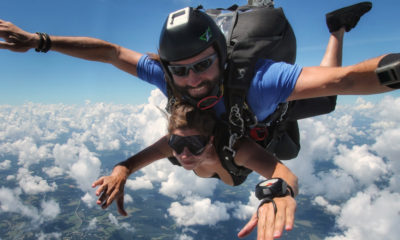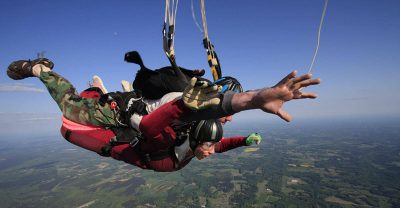Skydiving is an exhilarating adventure sport that is growing in popularity, specifically in the United States, with the largest recorded number of jumps – 3.9 million – made in 2022. With the increased number of skydiving participants mixed with the constant improvements made in skydiving technology, you may be wondering how often parachutes fail and how safe is skydiving, really? Let’s get into some up-to-date parachute statistics!
How Safe is Skydiving?
 First, let’s determine how safe skydiving is based on the latest statistics released by the United States Parachute Association (USPA). Out of the 3.9 million jumps made by over 42,000 USPA member skydivers in 2022, 20 of those jumps were recorded as fatal skydiving accidents. This makes the skydiving fatality rate 0.51 fatalities per 100,000 jumps amongst skydivers. For tandem skydiving, the safety rate is even better with one student fatality per every 500,000 jumps on the average over the last decade. This makes the odds of dying on a tandem skydive just 0.0002%.
First, let’s determine how safe skydiving is based on the latest statistics released by the United States Parachute Association (USPA). Out of the 3.9 million jumps made by over 42,000 USPA member skydivers in 2022, 20 of those jumps were recorded as fatal skydiving accidents. This makes the skydiving fatality rate 0.51 fatalities per 100,000 jumps amongst skydivers. For tandem skydiving, the safety rate is even better with one student fatality per every 500,000 jumps on the average over the last decade. This makes the odds of dying on a tandem skydive just 0.0002%.
What is the Cause of Most Skydiving Deaths?
Just like any physical activity, or any daily activity for that matter, skydiving involves a carefully calculated amount of risk. While some may assume that a skydiving death was most likely attributed to a parachute failure, this couldn’t be further from the truth.
In all actuality, most fatalities are highly experienced, D-licensed skydivers (with more than 500 jumps) making an intentional or unintentional low turn with their parachute. In 2022, 50% of skydiving deaths were D-licensed skydivers, and 58% of skydiver deaths have been D-licensed skydivers over the past 20 years.
The fact is that the vast majority of skydiving accidents are a result of human error, or an experienced jumper making an error in judgment while landing a perfectly functioning parachute — and not at all related to equipment failure. In 2022, 10% (2) of the fatalities were caused by an equipment issue, 10% were related to a medical problem, and 80% were intentional or unintentional errors.
Chances of Parachute Failing While Skydiving
The chances of a parachute failing are far less common than you would think. In skydiving, the failure of the main parachute to operate properly or the failure of the parachute to open is called a parachute malfunction. In 2021, one out of 721 skydivers reported using emergency procedures due to a parachute malfunction. There are two main types of parachute malfunctions:
- Total Malfunction: The parachute is not activated or is activated, but does not deploy.
- Partial Malfunction: The parachute deployed, but it is not landable.
Why Would a Parachute Malfunction?
There are many reasons why a parachute would malfunction. Here are the three primary causes of a parachute malfunction according to the USPA:
- Improper or careless packing.
- Poor or unstable body position during parachute deployment.
- Faulty equipment.
All skydivers are fully trained in the correct parachute packing procedures and in the correct body position for a successful parachute deployment. But even with all of the proper precautions taken, parachute malfunctions can still happen through human error or simple chance.
Is There a Backup Parachute When Skydiving?
 The skydiving rig (the cool-looking backpack we wear) is equipped with a two-parachute system, one being the “main” parachute and the other the “reserve” parachute. The reserve parachute is a “backup” parachute that is in place to use only if the main parachute malfunctions.
The skydiving rig (the cool-looking backpack we wear) is equipped with a two-parachute system, one being the “main” parachute and the other the “reserve” parachute. The reserve parachute is a “backup” parachute that is in place to use only if the main parachute malfunctions.
The reserve parachute is to be packed ONLY by a FAA-certified, professional parachute rigger. Repacks are required every 180 days, regardless of whether the reserve parachute has been used during that time.
What Happens if Parachute Fails?
Skydivers are trained on how to identify if a canopy is safe to land. They’ll ask themselves three questions:
- Is it there? The canopy is above you and has opened.
- Is it square? The canopy is completely inflated and in a rectangular shape.
- Is it steerable? The canopy is maneuverable by using the toggles.
If these three criteria are not met, the jumper assumes that the parachute has malfunctioned. Skydivers are trained to perform emergency procedures to manage the situation should the parachute malfunction for any reason.
So, what happens if the parachute fails when skydiving? In the rare case that the main parachute malfunctions, the skydiver follows their learned emergency procedures to cut away the malfunctioned parachute and deploy the backup reserve parachute. The decision to cut away the main parachute should be made no lower than 2,500 ft in altitude for students or A-license holders, and no lower than 1,800 ft for B-D licensed skydivers.
If this happens on a tandem skydive, you will likely not play an active role in dealing with the parachute malfunction – try to keep calm and trust that your instructor will handle the malfunction appropriately.
What Happens if Both Parachutes Fail?
What are the chances of two parachutes failing? When speaking about the reserve deployment, the chances of the parachute not opening are basically non-existent – mostly because of the diligent care that goes into packing a reserve parachute. If the skydiver is for any reason unable to deploy their own reserve parachute (due to unconsciousness or any other reason), the Automatic Activation Device (AAD) will automatically deploy the reserve parachute for them. There are other support systems in place to also aid in the deployment of the reserve parachute such as the RSL (reserve static line) and MARD (main assisted reserve deployment).
There’s no need to worry about your parachute malfunctioning, our instructors at Skydive Monroe are highly trained to handle these situations as best as possible to get you safely back on the ground. If you have more questions please reach out to one of our helpful team members for more information. Blue skies!
Copyright © 2024, Skydive Monroe, All Rights Reserved.
DropZone Web Design & Marketing by Beyond Marketing, LLC



